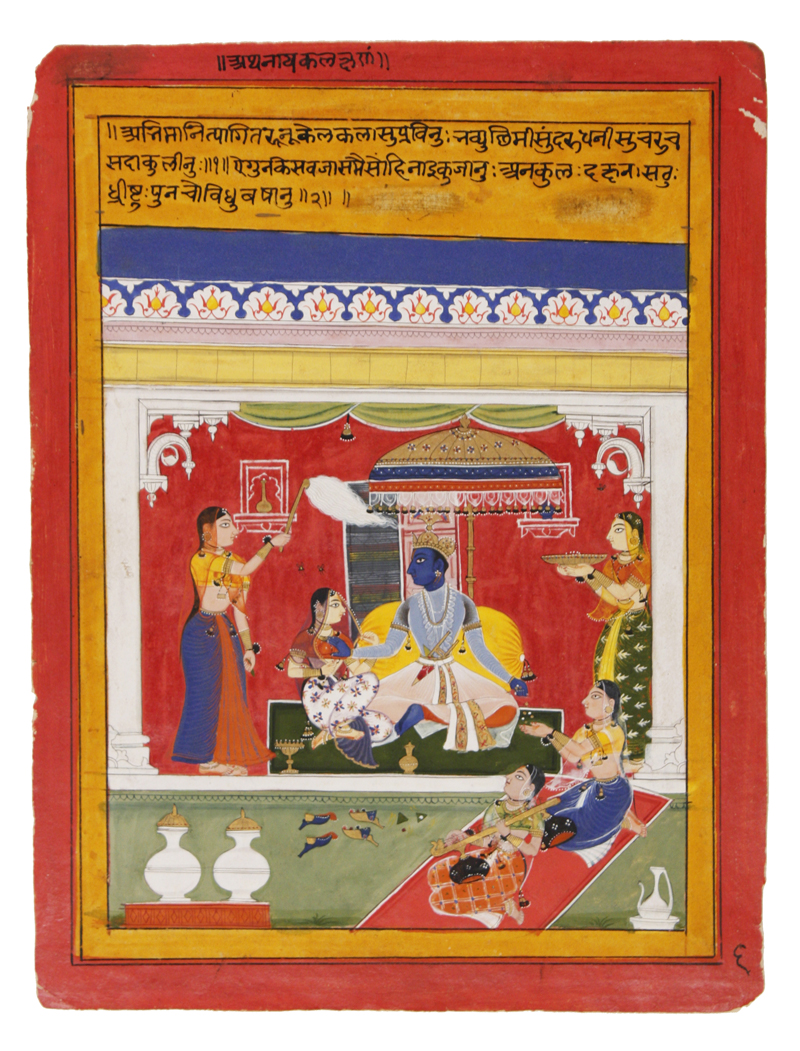A new exhibit at The Fralin Museum of Art at the University of Virginia offers a unique entry into the world of early modern India through an array of colorful paintings.
“Realms of Earth and Sky: Indian Paintings from the 15th to the 19th Century,” on view through Dec. 14, includes several artistic traditions that range across the span of centuries.
This is art made for emperors and empresses, kings and queens, and wealthy merchants. The exhibit reveals what they saw – and links the viewer directly to worlds far away and long ago.
The museum began seeking South Asian art in 1992, eventually acquiring a collection that today ranks among the best held by a university museum in the Southeast. The new exhibition comprises a selection of these works, supplemented by others drawn from private collections.
“Realms of Earth and Sky” was curated by Daniel J. Ehnbom, adjunct curator of South Asian art for The Fralin and associate professor of South Asian art in the U.Va McIntire Department of Art, along with Krista Gulbransen, visiting assistant professor of art history from Skidmore College and former Luzak-Lindner Graduate Fellow at The Fralin.
“For me, the color of the art is intoxicating,” Ehnbom said. “That’s what drew me to the pictures when I first saw them. In the more conservative styles, the pure reds and yellows are truly dazzling, and no viewer will forget the daring juxtapositions of blocks of color.”
One focus of the exhibit is Mughal painting, a style of South Asian art confined to miniatures such as book illustrations or as works kept in albums, which developed in the court of the Mughal Empire and then spread to other Indian courts.
“When the refinement and controlled colors introduced by Mughal painting come to the fore in this exhibit, the viewer is drawn into a world of subtle elegance,” Ehnbom said.
In addition, for the first time in its history, The Fralin has created an app specifically for an exhibition. Now a viewer can move easily from one section to another, use their smart phone to listen to authoritative commentary by the exhibition’s curator, focusing upon individual works in any order.
The app also includes a helpful glossary to help viewers understand unfamiliar Indian names and terms.
“I think that such apps may eventually even replace the printed catalogue for some exhibitions,” Bruce Boucher, director of The Fralin, said. “We are very pleased with the results in this case.”
Portraiture, religious and literary texts, and Ragamala paintings – a series of illustrative paintings based on “The Garland of Ragas,” depicting various Indian musical modes or ragas – are particularly well-represented in the The Fralin’s collection. Exhibit themes include the stylistic relationship between Mughal and Rajput paintings (Rajput kingdoms rose to prominence during the ninth and 12th centuries) and the function of book illustration.
In meticulously rendered tableaux, viewers will encounter scenes ranging from the opulence of the Mughal court to the actions of gods in the forms of men, and from lively battles to depictions of intimate courtly love. The styles are intricately refined or sweepingly bold, all contained in the small scale of the manuscript or album page.
“An Indian miniature is a tangible and material connection with the past,” Ehnbom said. “We see what the artist and the patron saw, we touch what they touched, and in so doing, we become part of a chain that stretches back to artists both known and unknown, to patrons ranging from merchants and aristocrats to the kings and emperors of South Asia.”
A catalogue accompanying the exhibition documents The Fralin’s Indian painting collection and features essays and entries written by Ehnbom and Gulbransen. Since many of the Indian works in the museum’s collection remain unpublished, the catalogue also represents an important contribution to current scholarship on Indian painting.
The Fralin Museum of Art’s programming is made possible by the support of The Joseph & Robert Cornell Memorial Foundation. The exhibition is made possible through the support of the Office of the Executive Vice President and Provost and the Vice Provost for the Arts, The Fralin Museum of Art Volunteer Board, the E. Rhodes and Leona B. Carpenter Foundation, the Weedon Foundation, U.Va. Arts Council: Enriching the Arts on Grounds, an anonymous donor, WTJU 91.1 FM, Albemarle Magazine and Ivy Publications LLC’s Charlottesville Welcome Book.
Media Contact
Article Information
August 29, 2014
/content/new-fralin-museum-exhibit-captures-dazzle-early-indian-painting

